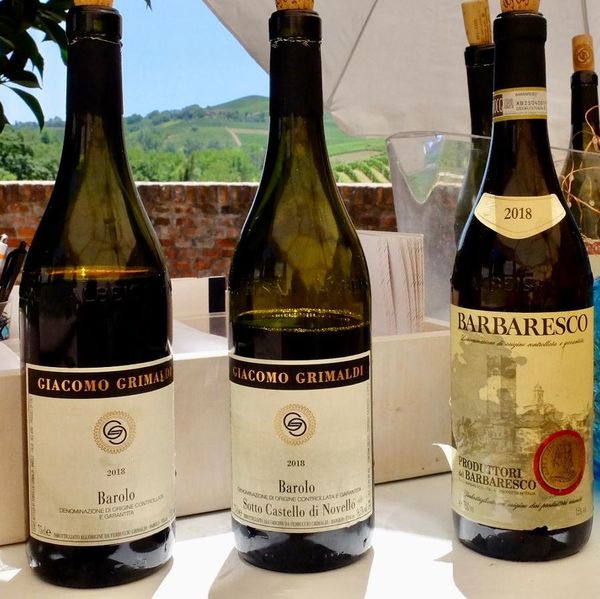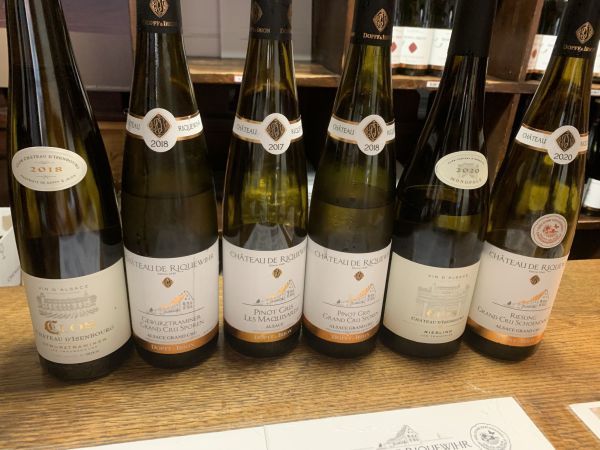
Having just returned from Piedmont in NW Italy, it is an ideal opportunity to share my passion for this most intriguing of grape varieties and its expression in the classic wines of the region.
The Grape
Italy’s greatest grape variety, responsible for some of the finest and most long-lived wines in the world.
The variety buds early (making it susceptible to spring frost) and also ripens late, typically in October when the hills of Piemonte are often cloaked in fog. In fact, the name is derived from the Italian word Nebbia (fog).
Because it is early budding, Nebbiolo is always planted on hillsides (to avoid the worst risk of frost in the valleys) and usually on South or South-West facing slopes for maximum exposure to the sun.
In addition to demanding the best aspect, Nebbiolo is also very fussy about soil types. The best results are found where it is planted on calcareous marls (a type of limestone) around the town of Alba, and especially in Barolo and Barbaresco.
Nebbiolo is also very fussy about weather. It requires plenty of heat and sunlight to ripen fully. It is prone to problems resulting from excess rainfall during flowering in early summer and also needs warm, dry autumns to ripen fully.
Because it is so fussy, it has hardly been plated at all outside of its traditional Italian homeland.
Italian winemakers regard Nebbiolo as their very own Pinot Noir. Its appearance can be similar and it is if anything even more demanding and fussy about where it grows.
Traditional winemaking techniques used with Nebbiolo are long maceration times to extract as much colour (and tannin!) as possible followed by long-ageing in large oak barrels. This still requires extended time in bottle before the tannin is soft enough to be palatable. More “modern” winemaking sees reduced extraction and shorter maturation in smaller (Bordeaux style) barrels
Enjoying Nebbiolo
The wine produced by Nebbiolo is deceptive in appearance. It usually has a pale intensity and even at a relatively young age is often “garnet” (brick-red/orange) in hue, a phenomenon usually associated with older wines. The paleness is however no preparation for the shock to the palate produced by the very high levels of tannin (and acidity) common in this variety. If no one has introduced you to the term “Grippy Tannins”, try a youngish Nebbiolo to see what they mean!
Oak ageing and further bottle ageing will soften those tannins, and many top-quality wines are practically undrinkable in their youth. Also notable on the palate is the usually high level of alcohol and medium-full bodied mouthfeel, combined with a long finish in the better examples.
However, it is on the (often pronounced) nose where this wine really shines. In its youth it combines floral notes such as rose and violets with red fruits such as cherry, strawberry and raspberry. Riper examples may also have some black fruit as well as liquorice. Because of the high tannin and acidity, wines made from fully ripe grapes have a wonderful ability to age. With age comes softer tannins, but also an explosion of mature (tertiary) wine aromas such as leather, mushroom, truffles and its signature note – tar. In fact, the shorthand for mature Nebbiolo is “tar and roses”.
What To Eat with It?
Nebbiolo wines really DO need food to go with them. Whilst wine connoisseurs may wax lyrical over the perfume, complexity, structure, elegance and power of these wines, for most people it can all be a bit much without some food to go with it.
The key to enjoying wine with tannin is fat. Fat in food and tannin in wine work well together. The fat will soften the tannin on the palate and the tannin will help to cleanse the palate between mouthfuls.
In addition, its an absolute truism that local wine and food work best together. In this case Italian food and even better Piemonte dishes.
For example:
- Mushroom risotto
- Chicken liver risotto
- Veal dishes, especially Osso Buco
- Duck and Goose
- Beef casserole with polenta
- Brasato (beef cooked in Barolo)
- Rib of Beef
- Griddled steaks
- Spicy sausages
- Salami & Prosciutto
- Beef Carpaccio
- Cheese, especially Italian
Where It Grows
Almost all Nebbiolo is planted in Italy, the vast majority in Piemonte (Piedmont). The structure of Italian wine labelling is (somewhat!) complex but can be summarised as like the French with their Appellation d’Origine contrôlée (AOC) system they have their DOC and DOCG labels – the latter usually denotes a wine of higher quality, although like all things Italian there is devil in the detail. These labels denote the specific geographic area of a wine’s origin and specify what grapes can be used and various technical details about vineyard management and wine production methods.
Like the French system, Italian wine labelling also reflects a regional-area-village-vineyard hierarchy with more prestigious wines having more specific origins.
In the case of the Nebbiolo wines of Piedmont there are several DOC/DOCG where this grape can be used (this is not an exhaustive list and omits some of the smaller DOC/DOCG in Northern Piemonte such as Gattinara & Ghemme).
Piemonte Nebbiolo DOC – A catch-all label for the entire province of Piemonte. Piemonte DOC produces a lot of wine from many different varieties and a small amount is from Nebbiolo. Most Nebbiolo produced in Piemonte is from the more specific and higher quality sub regions. NB: for this DOC, Nebbiolo only needs to comprise a min. 0f 85% of the wine
Langhe Nebbiolo DOC – Nebbiolo is one of many varietally labelled wines produced in the Langhe region. This is a generic label covering vineyards outside of the more prestigious and famous ones shown below. NB: for this DOC, Nebbiolo only needs to comprise a min. 0f 85% of the wine
Nebbiolo d’Alba DOC – Alba is the principal town in the Langhe region and has vineyards all around it. More specific and locally labelled wine than the generic Langhe DOC and therefore (at least in theory) of potentially higher quality.
Roero DOCG – A small area north of Alba, most is white wine from the Arneis grape, but there is also some red wine made from Nebbiolo (min. 95%). From good producers, the best of these compare well with the famous wines from a little further south.
Barolo DOCG – “The King of Wines, The Wine of Kings”. Indisputably the most famous and prestigious expression of the Nebbiolo grape, SW of the town of Alba, nestling amongst rolling hills. Barolo will be covered in more detail in the next article but for now to summarise; the wines are relatively pale in colour yet with powerful tannins and rasping acidity. The aromas are pronounced and because of the structure of the wine they can age and develop for many years.
Barbaresco DOCG – “The Queen alongside the King” – The king being of course Barolo. Barbaresco is to the East of Alba and is slightly lower than Barolo, with grapes ripening a week earlier. They are therefore (slightly) less powerful, (slightly) less tannic and mature (a little) more quickly than their more famous counterpart. Barbaresco wines are also intensely perfumed with great structure allowing development over many years. They are enjoyable at a younger age than Barolo and don’t age to quite the same extent.
Watch out for the next article – Barolo in detail.

.jpg)

.jpg)